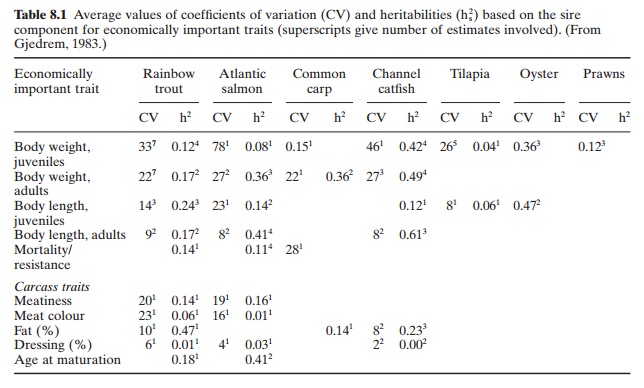Chapter: Aquaculture Principles and Practices: Reproduction and Genetic Selection
Genetic selection and hybridization in Aquaculture
Genetic selection and
hybridization
The use of genetically selected strains and hybrids has contributed very
substantially to modern agriculture and animal husbandry. But aquaculture is
yet to gain much from efficient breeding and selection programmes. Among the
many reasons for this are the delays in the development of suitable techniques
for controlled reproduction of many farmed species and the paucity of genetic
expertise among aquaculturists. Genetic improvements usually require long-term
experimentation with a large number of individuals and generations, and so
considerable time may elapse before useful results become available. Moreover
research on farming technologies has not reached that level in most cases, when
the only way to improve production is by genetic improvement of the stocks.
Except in a few cases, the present technologies are too inefficient to benefit
from the use of selected stocks.
In traditional aquaculture, certain strains have evolved as a result of
environmental or farming conditions without much conscious effort by the
aquaculturist, as in the case of the common carp, or as a result of
rule-of-thumb selection. These more or less accidental strains can seldom be
used with confidence for commercial farming.
There is no doubt that effective selective breeding programmes are
expensive and require more facilities than are presently available in most
aquaculture farms or even institutions that can function as central stations
for breeding and distribution of aquaculture species. Though the economic
benefits of selection programmes have been worked out for domestic animals,
comparable evaluations are few in aquaculture.
As pointed out earlier, the number of domesticated species used in
aquaculture for food islimited (unlike culture of ornamental species), but the
number is steadily growing. Opportunities to increase the production properties
and adaptation to a new environment of species through selection can therefore
be expected to expand in the future. Kirpichnikov (1966) gives some of the main
aims of fish selection as follows:
1.
to increase the growth rate by
better utilization of food (physiological decrease of food expenditure per unit
of growth increment);
2.
to increase the growth rate by
fuller utilization of natural food in ponds and higher consumption of feed
mixtures;
3.
to increase resistance to oxygen
deficiency, to high or low temperature, to higher salinity or to other deviations
from the normal environmental conditions;
4.
to improve resistance to
infectious diseases and to infestation of parasites (to develop new breeds
resistant to particular diseases);
5.
to improve the nutritive
properties of fish (to increase the calorie content, to decrease the
proportional weight of non-edible parts, to decrease the bone content, to
increase or decrease the fat content, etc.).
Other aims may include speeding up of sexual maturation, the ability to
reproduce at relatively low temperatures and the slowing down of maturation to
prevent early switching over of metabolism to develop sex products, affecting
growth and resulting in prolific reproduction.
The main disadvantages of fish for genetic breeding are the rather long
generation interval of many species, particularly in cold climates, and the
hierarchies that may develop in fish populations and that may contribute to
size variations.
Genetic gains through selection, as in the case of salmonids, are
dependent on selection differentials and genetic variance of the relevant
traits, which are inversely related to the length of the generation interval.
Gjedrem (1983) presents average estimates of heritability and a coefficient of
variation (CV = (sp/x) x 100) of several species,
as shown in Table 8.1.

The relative advantages of a fish in genetic breeding schemes are
brought out by Skjervold (1976), using salmonids as an example. Among the most
important of these are:
·
Very high fertility, leading to
high ‘litter’ of considerable importance in selection work.
·
External fertilization, which
makes it possible to have several combinations of matings and the production of
many ‘litters’ of large numbers of half-siblings.
·
The high fertility of females,
which enables:
a)
some types of family selection,
even when the heritability of the selected trait is low, as large family groups
will in practice result in rather accurate estimation of the breeding value;
b)
progeny testing among females,
which can be carried out by using mixed sample of semen, or semen from sires of
known breeding value;
c)
the improved possibility of
estimating non-additive genetic components, because of the combination of high
female fertility and external fertilization;
d)
artificial manipulation of
chromosome content, which is facilitated by external fertilization; and
e)
easier hybrid production due to
high female fertility and the remarkable ability for crossing as observed in
nature.
The high phenotypic variance of the body weight of adults, together with
the medium heritability as seen in Table 8.1, show that there is a large
genetic variance for this trait for these species. Though mortality shows low
heritability, resistance to specific diseases shows medium to high
heritability. Similarly, the meat quality traits show some genetic variation,
though it is low in the dressing percentage. Age at sexual maturation shows
medium heritability in rainbow trout but a high one in the Atlantic salmon. The
conclusion is that the possibility of genetic gains from selection programmes
in aquatic animals is high and compares favourably with terrestrial animals and
plants.
Related Topics